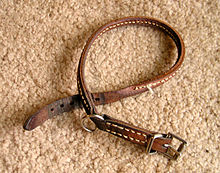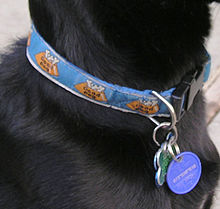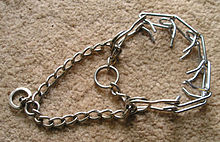- Dog collar
-
A dog collar is a is a piece of material put around the neck of a dog. A collar might be used for control, identification, fashion, or other purposes. Identification tags and medical information is often placed on dog collars. Collars are also useful for controlling a dog manually, as they provide a handle for grabbing. Collars are often used in conjunction with a leash, and a common alternative to a dog collar is a dog harness. Dog collars are the most common form of directing and teaching dogs.[1]
Dog collar is also an informal term for the clerical collar used by Anglican vicars and other clergy.[2]
Contents
Basic collars
- Buckle collars, also called flat collars, are usually made of nylon webbing or leather (less common materials can include polyester, hemp, or metal) with a buckle similar to a belt buckle, or a quick-release buckle, either of which holds the collar loosely around the dog's neck. Identification is commonly attached to such a collar; it also comes with a loop to which a leash can be fastened.
- Flea collars are impregnated with chemicals that repel fleas. They are usually a supplementary collar, worn in addition to the conventional buckle collar.
- Elizabethan collars, shaped like a truncated cone, can be fitted on a dog to prevent it from scratching a wound on its head or neck or licking a wound or infection on its body.
- Break-away collars look similar to buckle collars, but have a safety mechanism installed that allows the dog to break free of the collar if excessive force is applied. These collars are useful in situations where a non-quick release collar could get snagged and strangle the dog.
- Safety Stretch Collars an elastic panel in the sturdy nylon collar allows escape from potential strangulation dangers such as branches, fences, gates and other dogs. Unlike breakaways a stretch collar acts like a traditional static collar when clipped with a leash.
- Stud collars are leather collars fitted with dulled points and/or metal studs that traditionally prevented another animal from biting the dog's neck. In modern societies, stud collars are more commonly considered a fashion accessory.
Training collars
Several types of collars are used for the purposes of training dogs, though sometimes a collar is not used at all (such as in the case of dog agility training, where a collar could get caught on equipment and strangle the dog). Each training collar has its own set of advantages and disadvantages (briefly outlined below) which trainers might consider before using a select one. Training collars are typically used for training only and not left on the dog's neck all the time, as some collars can be harmful or dangerous if left on a dog unsupervised.
Flat collars
Some dogs are trained on leash using a buckle or quick-release collar.
Slip collars
Slip collars (also called choke chains, slip chains, or choke collars) are a length of chain or nylon rope with rings at either end such that the collar can be formed into a loop around the top of the dog's neck, just behind the ears. The ring which connects to the leash goes over the back of the dog's neck, not under.[1] When the leash is attached to the dead ring the collar does not constrict on the dog's neck. When the leash is attached to the live ring the chain slips (adjusts) tighter when pulled and slips looser when tension is released. A quick jerk with an immediate release, euphemistically called a leash pop, snap, or correction, is used to coerce the dog into a 'heel' position.
Prong collar
Prong collars (sometimes incorrectly termed 'pinch collars') are a series of chain links with blunted open ends turned towards the dog's neck. The design of the prong collar is such that it has a limited circumference unlike slip collars which do not have a limit on how far they can constrict on a dog's neck. The limited traction of the martingale chain combined with the angle of the prongs prevents the prongs moving close enough to pinch. The collar is designed to prevent the dog from pulling by applying pressure at each point against the dog's neck.
Prong collars must never be turned inside out (with the prongs facing away from the dog's skin), as this may cause injury against the body and head. [2] Plastic tips are occasionally placed on the ends of the prongs to protect against tufts forming in the fur or, in the case of low quality manufactured collars with rough chisel cut ends, puncturing the skin. Like the slip collar, the prong collar is placed high on the dog's neck, just behind the ears, at the most sensitive point.[3]
Some dogs can free themselves from prong collars with large wire looped sides by shaking their head so that the links pop out, so some trainers have come to use a second collar (usually an oversize slip collar) in addition to the prong collar so when this happens the dog does not run loose.
Martingale collar
Martingale collars are recommended for Sighthounds because their heads are smaller than their necks and they can often slip out of standard collars. They can, however, be used for any breed of dog. Their no-slip feature has made them a safety standard at many kennels and animal shelters[citation needed]. A martingale collar has 2 loops; the smaller loop is the "control loop" that tightens the larger loop when pulled to prevent dogs from slipping out of the collar. Similar to a prong collar, the martingale has limited constriction on the dog's neck and applies even pressure.
Head halters
Head halters, sold under the brand names Halti or Gentle Leader or Snoot Loop, are similar in design to a halter for a horse. This device fastens around the back of the neck and over the top of the muzzle, giving more control over a dog's direction and the intensity of pulling on a leash than collars that fit strictly around the neck. Pressure on this type of collar pulls the dog's head towards the handler.
Controversy
Supporters of the head halter say that it enables the handler to control the dog's head, and makes the dog unable to pull using its full strength. It is especially useful with reactive dogs, when control of the dog's head can be a safety issue.[citation needed]
Those who do not recommend use of the head halter say that some dogs find it unnatural and uncomfortable[citation needed]. If the collar is too tight, it may dig too deeply into the skin or the strap around the muzzle may push into the dog's eyes[citation needed]. Cranial injury is a possible result from improper use of the head halter; if a dog is jerked suddenly by the leash attached to the head halter, the dog's neck is pulled sharply to the side, which might result in neck injury (though this can be true of all collars). If the nose strap is fitted too tightly, the hair on the muzzle can also be rubbed off, or the dog might paw and scratch at its face, causing injuries ranging from mere bare skin to severe abrasions.
Shock collars
Shock collars (or training collars, remote training collars, e-collars, electronic collars and hunting collars) are electronic training aids developed to deliver an electrical signal, vibration, tone, through contact points attached to a dog collar.
Wolf collars
Wolf collars or protection collars are metal collars fitted with large spikes radiating away from the dog, usually worn by dogs protecting livestock in case they are attacked by wolves or other predators. Such collars protect the neck of a dog from direct attack. It is rare to see these collars being used in modern societies.
JASA Force Collar
A force collar is a leather collar with metal prongs staggered along the inside; similar to a prong collar.
Lighted Collar
A lighted collar (or collar light, dog light) is a collar that emits light in order to make a dog more visible in the dark to their owners and more importantly, nearby motorists. It should be noted that it is not designed to help a dog see at night, as it is well documented that dogs have very good vision in low light conditions.
Most lighted collars utilize one or more light emitting diodes for the light source and can be of virtually any color, although red and blue are most common. Power is provided by one or more batteries, most common types being AAA and lithium coin cells to minimize the added weight to the collar.
Flotation collar
A flotation collar (or buoyant collar) is a buoyancy aid designed for dogs. Although it is not designed to be used as a life preserver or life jacket, it can provide additional buoyant support for the head of a dog when in the water. It is often used in canine hydrotherapy services to assist in the rehabilitation of injured dogs. The collar may be constructed of closed cell foam material that is inherently buoyant or be of a type that is inflated with air.
See also
- Collar
- Shock collar
- The Dog Collar Museum at Leeds Castle, Kent, England
References
- ^ Hodgson, Sarah (2006). Teach Yourself Visually Dog Training. Wiley Default. ISBN 0471749893.
- ^ BBC item using "dog collar" to refer to clerical collars
External links
Categories:- Dog equipment
- Dog training and behavior
- Animal identification
Wikimedia Foundation. 2010.






